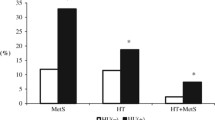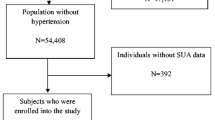Abstract
The association between serum uric acid and the risk of incident diabetes in Chinese adults remains unknown. This study aimed to investigate this association in a community-dwelling population aged ≥ 40 years in Shanghai, China. Oral glucose tole3rance test was conducted during baseline and follow-up visits. Relative risk regression was utilized to examine the associations between baseline gender-specific serum uric acid levels and incident diabetes risk. A total of 613 (10.3%) incident diabetes cases were identified during the follow-up visit after 4.5 years. Fasting plasma glucose, postload glucose, and glycated hemoglobin A1c during the follow-up visit progressively increased across the sex-specific quartiles of serum uric acid (all Ps < 0.05). The incidence rate of diabetes increased across the quartiles of serum uric acid (7.43%, 8.77%, 11.47%, and 13.43%). Multivariate adjusted regression analysis revealed that individuals in the highest quartile had 1.36-fold increased risk of diabetes compared with those in the lowest quartile of serum uric acid (odds ratio (95% confidence interval) = 1.36 (1.06–1.73)). Stratified analysis indicated that the association was only observed in women. Accordingly, serum uric acid was associated with the increased risk of incident diabetes among middle-aged and elderly Chinese women.
Similar content being viewed by others
References
Bommer C, Heesemann E, Sagalova V, Manne-Goehler J, Atun R, Bärnighausen T, Vollmer S. The global economic burden of diabetes in adults aged 20–79 years: a cost-of-illness study. Lancet Diabetes Endocrinol 2017; 5(6): 423–430
Chen-Xu M, Yokose C, Rai SK, Pillinger MH, Choi HK. Contemporary prevalence of gout and hyperuricemia in the United States and decadal trends: the National Health and Nutrition Examination Survey, 2007–2016. Arthritis Rheumatol 2019; 71(6): 991–999
Juraschek SP, McAdams-Demarco M, Miller ER, Gelber AC, Maynard JW, Pankow JS, Young H, Coresh J, Selvin E. Temporal relationship between uric acid concentration and risk of diabetes in a community-based study population. Am J Epidemiol 2014; 179(6): 684–691
Major TJ, Dalbeth N, Stahl EA, Merriman TR. An update on the genetics of hyperuricaemia and gout. Nat Rev Rheumatol 2018; 14 (6): 341–353
White J, Sofat R, Hemani G, Shah T, Engmann J, Dale C, Shah S, Kruger FA, Giambartolomei C, Swerdlow DI, Palmer T, McLachlan S, Langenberg C, Zabaneh D, Lovering R, Cavadino A, Jefferis B, Finan C, Wong A, Amuzu A, Ong K, Gaunt TR, Warren H, Davies TL, Drenos F, Cooper J, Ebrahim S, Lawlor DA, Talmud PJ, Humphries SE, Power C, Hypponen E, Richards M, Hardy R, Kuh D, Wareham N, Ben-Shlomo Y, Day IN, Whincup P, Morris R, Strachan MWJ, Price J, Kumari M, Kivimaki M, Plagnol V, Whittaker JC, Smith GD, Dudbridge F, Casas JP, Holmes MV, Hingorani AD; UCLEB (University College London-London School of Hygiene & Tropical Medicine-Edinburgh-Bristol Consortium). Plasma urate concentration and risk of coronary heart disease: a Mendelian randomisation analysis. Lancet Diabetes Endocrinol 2016; 4(4): 327–336
Bhole V, Choi JW, Kim SW, de Vera M, Choi H. Serum uric acid levels and the risk of type 2 diabetes: a prospective study. Am J Med 2010; 123(10): 957–961
Dai CY, Chuang WL, Ho CK, Ou TT, Huang JF, Hsieh MY, Yu ML. High serum uric acid as a novel risk factor for type 2 diabetes: response to Dehghan et al. Diabetes Care 2008; 31(9): e67
Dehghan A, van Hoek M, Sijbrands EJ, Hofman A, Witteman JC. High serum uric acid as a novel risk factor for type 2 diabetes. Diabetes Care 2008; 31(2): 361–362
Boner G. Uric acid and diabetes. Lancet 1982; 320(8309): 1224
Han T, Meng X, Shan R, Zi T, Li Y, Ma H, Zhao Y, Shi D, Qu R, Guo X, Liu L, Na L, Li Y, Sun C. Temporal relationship between hyperuricemia and obesity, and its association with future risk of type 2 diabetes. Int J Obes 2018; 42(7): 1336–1344
Liu J, Tao L, Zhao Z, Mu Y, Zou D, Zhang J, Guo X. Two-year changes in hyperuricemia and risk of diabetes: a five-year prospective cohort study. J Diabetes Res 2018; 2018: 6905720
Wang Y, Chi J, Che K, Chen Y, Sun X, Wang Y, Wang Z. Fasting plasma glucose and serum uric acid levels in a general Chinese population with normal glucose tolerance: a U-shaped curve. PLoS One 2017; 12(6): e0180111
Tuomilehto J, Zimmet P, Wolf E, Taylor R, Ram P, King H. Plasma uric acid level and its association with diabetes mellitus and some biologic parameters in a biracial population of Fiji. Am J Epidemiol 1988; 127(2): 321–336
Keenan T, Zhao W, Rasheed A, Ho WK, Malik R, Felix JF, Young R, Shah N, Samuel M, Sheikh N, Mucksavage ML, Shah O, Li J, Morley M, Laser A, Mallick NH, Zaman KS, Ishaq M, Rasheed SZ, Memon FU, Ahmed F, Hanif B, Lakhani MS, Fahim M, Ishaq M, Shardha NK, Ahmed N, Mahmood K, Iqbal W, Akhtar S, Raheel R, O’Donnell CJ, Hengstenberg C, März W, Kathiresan S, Samani N, Goel A, Hopewell JC, Chambers J, Cheng YC, Sharma P, Yang Q, Rosand J, Boncoraglio GB, Kazmi SU, Hakonarson H, Köttgen A, Kalogeropoulos A, Frossard P, Kamal A, Dichgans M, Cappola T, Reilly MP, Danesh J, Rader DJ, Voight BF, Saleheen D. Causal assessment of serum urate levels in cardiometabolic diseases through a Mendelian randomization study. J Am Coll Cardiol 2016; 67(4): 407–416
Kivity S, Kopel E, Steinlauf S, Segev S, Sidi Y, Olchovsky D. The association between serum uric acid and diabetes mellitus is stronger in women. J Womens Health (Larchmt) 2013; 22(9): 782–789
Lu J, Zhang J, Du R, Wang T, Xu M, Xu Y, Wang W, Bi Y, Li D, Chen Y, Ning G. Age at menarche is associated with the prevalence of non-alcoholic fatty liver disease later in life. J Diabetes 2017; 9 (1): 53–60
Li M, Xu Y, Xu M, Ma L, Wang T, Liu Y, Dai M, Chen Y, Lu J, Liu J, Bi Y, Ning G. Association between nonalcoholic fatty liver disease (NAFLD) and osteoporotic fracture in middle-aged and elderly Chinese. J Clin Endocrinol Metab 2012; 97(6): 2033–2038
Chen Y, Lu J, Huang Y, Wang T, Xu Y, Xu M, Li M, Wang W, Li D, Bi Y, Ning G. Association of previous schistosome infection with diabetes and metabolic syndrome: a cross-sectional study in rural China. J Clin Endocrinol Metab 2013; 98(2): E283–E287
Lee PH, Macfarlane DJ, Lam TH, Stewart SM. Validity of the International Physical Activity Questionnaire Short Form (IPAQSF): a systematic review. Int J Behav Nutr Phys Act 2011; 8(1): 115
Lloyd-Jones DM, Hong Y, Labarthe D, Mozaffarian D, Appel LJ, Van Horn L, Greenlund K, Daniels S, Nichol G, Tomaselli GF, Arnett DK, Fonarow GC, Ho PM, Lauer MS, Masoudi FA, Robertson RM, Roger V, Schwamm LH, Sorlie P, Yancy CW, Rosamond WD; American Heart Association Strategic Planning Task Force and Statistics Committee. Defining and setting national goals for cardiovascular health promotion and disease reduction: the American Heart Association’s strategic Impact Goal through 2020 and beyond. Circulation 2010; 121(4): 586–613
Pickering TG, Hall JE, Appel LJ, Falkner BE, Graves J, Hill MN, Jones DW, Kurtz T, Sheps SG, Roccella EJ; Subcommittee of Professional and Public Education of the American Heart Association Council on High Blood Pressure Research. Recommendations for blood pressure measurement in humans and experimental animals: Part 1: blood pressure measurement in humans: a statement for professionals from the Subcommittee of Professional and Public Education of the American Heart Association Council on High Blood Pressure Research. Hypertension 2005; 45(1): 142–161
Lin L, Peng K, Du R, Huang X, Lu J, Xu Y, Xu M, Chen Y, Bi Y, Wang W. Metabolically healthy obesity and incident chronic kidney disease: the role of systemic inflammation in a prospective study. Obesity (Silver Spring) 2017; 25(3): 634–641
Hertz-Picciotto I, Rockhill B. Validity and efficiency of approximation methods for tied survival times in Cox regression. Biometrics 1997; 53(3): 1151–1156
McNutt LA, Wu C, Xue X, Hafner JP. Estimating the relative risk in cohort studies and clinical trials of common outcomes. Am J Epidemiol 2003; 157(10): 940–943
Zoppini G, Targher G, Negri C, Stoico V, Perrone F, Muggeo M, Bonora E. Elevated serum uric acid concentrations independently predict cardiovascular mortality in type 2 diabetic patients. Diabetes Care 2009; 32(9): 1716–1720
Meisinger C, Thorand B, Schneider A, Stieber J, Döring A, Löwel H. Sex differences in risk factors for incident type 2 diabetes mellitus: the MONICA Augsburg cohort study. Arch Intern Med 2002; 162(1): 82–89
Yamada T, Fukatsu M, Suzuki S, Wada T, Joh T. Elevated serum uric acid predicts impaired fasting glucose and type 2 diabetes only among Japanese women undergoing health checkups. Diabetes Metab 2011; 37(3): 252–258
Nakanishi N, Okamoto M, Yoshida H, Matsuo Y, Suzuki K, Tatara K. Serum uric acid and risk for development of hypertension and impaired fasting glucose or type II diabetes in Japanese male office workers. Eur J Epidemiol 2003; 18(6): 523–530
Levine W, Dyer AR, Shekelle RB, Schoenberger JA, Stamler J. Serum uric acid and 11.5-year mortality of middle-aged women: findings of the Chicago Heart Association Detection Project in Industry. J Clin Epidemiol 1989; 42(3): 257–267
Wingrove CS, Walton C, Stevenson JC. The effect of menopause on serum uric acid levels in non-obese healthy women. Metabolism 1998; 47(4): 435–438
Chou P, Lin KC, Lin HY, Tsai ST. Gender differences in the relationships of serum uric acid with fasting serum insulin and plasma glucose in patients without diabetes. J Rheumatol 2001; 28 (3): 571–576
Johnson RJ, Nakagawa T, Sanchez-Lozada LG, Shafiu M, Sundaram S, Le M, Ishimoto T, Sautin YY, Lanaspa MA. Sugar, uric acid, and the etiology of diabetes and obesity. Diabetes 2013; 62 (10): 3307–3315
Zhou Y, Fang L, Jiang L, Wen P, Cao H, He W, Dai C, Yang J. Uric acid induces renal inflammation via activating tubular NF-kB signaling pathway. PLoS One 2012; 7(6): e39738
Mazzali M, Hughes J, Kim YG, Jefferson JA, Kang DH, Gordon KL, Lan HY, Kivlighn S, Johnson RJ. Elevated uric acid increases blood pressure in the rat by a novel crystal-independent mechanism. Hypertension 2001; 38(5): 1101–1106
Nakagawa T, Tuttle KR, Short RA, Johnson RJ. Hypothesis: fructose-induced hyperuricemia as a causal mechanism for the epidemic of the metabolic syndrome. Nat Clin Pract Nephrol 2005; 1(2): 80–86
Li C, Hsieh MC, Chang SJ. Metabolic syndrome, diabetes, and hyperuricemia. Curr Opin Rheumatol 2013; 25(2): 210–216
Acknowledgements
The authors would like to thank the field working staff for their contribution and the participants for their cooperation. This study was supported by the Ministry of Science and Technology of the People’s Republic of China (Nos. 2016YFC1305202 and 2016YFC1304904) and National Natural Science Foundation of China (Nos. 81670795 and 81870604). Yuhong Chen was supported by the Shanghai Shenkang Hospital Development Center for improving the control of type 2 diabetes in the suburbs of Shanghai (No. 16CR4020A).
Author information
Authors and Affiliations
Corresponding authors
Ethics declarations
Di Cheng, Chunyan Hu, Rui Du, Hongyan Qi, Lin Lin, XueyanWu, Lina Ma, Kui Peng, Mian Li, Min Xu, Yu Xu, Yufang Bi, Weiqing Wang, Yuhong Chen, and Jieli Lu declare that they have no conflict of interest. All procedures followed were in accordance with the ethical standards of the Institutional Review Board of Ruijin Hospital Affiliated to Shanghai Jiao Tong University School of Medicine and with the Helsinki Declaration of 1975, as revised in 2000. Informed consent was obtained from all patients for being included in the study.
Electronic Supplementary Material
Rights and permissions
About this article
Cite this article
Cheng, D., Hu, C., Du, R. et al. Serum uric acid and risk of incident diabetes in middle-aged and elderly Chinese adults: prospective cohort study. Front. Med. 14, 802–810 (2020). https://doi.org/10.1007/s11684-019-0723-7
Received:
Accepted:
Published:
Issue Date:
DOI: https://doi.org/10.1007/s11684-019-0723-7




